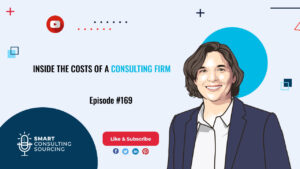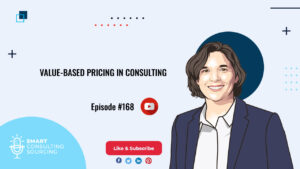Hi everyone, and welcome back to Smart Consulting Sourcing, the only podcast about consulting procurement.
In this episode of your series: “How to buy consulting services like a pro,” we will tell you how to set your RFP’s context accurately and effectively.
But before we get there, here is a recap of our last episode’s discussion about the secret sauce to an irresistible RFP and why a compelling intro showcasing your company’s background is crucial.
Many people dive right into the details of an RFP but neglect the crucial aspect of setting the stage for everyone involved – from new players to long-time partners. The solution is simple: spice up that intro and watch your project’s outcome sizzle with success!
To achieve this, a comprehensive background of the company should be included in the RFP. This thoroughly explains the company’s industry, geographical reach, and financials.
It’s also essential to have information on the department responsible for the project and any other relevant details. It’s also essential to explain how this project ties into your organization’s larger objectives and vision.
Consulting sourcing experts know how to balance providing too much information and not enough. This balance is found through repetition and experience.
But what about confidential information? Is it necessary to include it in the background of a project? The answer is yes, as long as it’s relevant to the matter at hand. However, ensuring that you have signed an NDA or confidentiality clause within your MSA or consulting agreement is vital to protect both parties involved.
Today’s episode is the second step in writing the perfect RFP, so be sure to listen to last week’s episode first. We don’t want you to miss out on any critical insights about consulting sourcing strategies!
If you want to catch up, you can find our episodes on Spotify, iTunes, YouTube, or read through the full transcripts on consultingquest.com’s Thought Leadership section. Don’t miss this one-of-a-kind opportunity to craft the perfect RFP for consulting services!
Crafting A Strong Context Is Key to a Successful RFP for Consulting Services
Now, it’s time to talk about describing the context of your project
This is so critical that it can make or break your RFP, so it’s essential to get it right.
There is a fine line between the background of the company and the context of the project.
As a rule, your company’s background should be the same for all projects launched in the same period, while the context will always be unique to the assignment described in the RFP.
In the context section, you want to explain why you are launching this consulting project and your primary expectations.
If you have doubts about what you want to do or can do with the support of a consultant, it can be a good idea to engage in a few conversations with consulting firms to progressively sharpen your views on the project. And don’t forget to check if you have an active NDA before you do that!
During these conversations, you might realize that you are embracing a too-large scope or that the project could be broken down into smaller pieces. It’s not unusual, and it’s better to make these realizations early rather than later. Why is it important? Well, the larger the scope, the higher the price.
But an enormous scope doesn’t always translate into a higher impact. You have to focus on what brings value. And sometimes, the scope you have in mind doesn’t make sense, and you might not realize it because you’re not a seasoned consultant. That’s where consulting sourcing experts like me can help.
To Create a Solid Context Section, Begin With the Basics
Now, let’s dive deeper into the context section of your RFP. This section should provide a high-level overview of the problem you’re trying to solve. To create a solid context section, begin with the basics: describe the state of your industry, outline the primary challenges you are facing, and summarize the actions you have taken so far to tackle these issues.
In addition, explain your ambitions for the future and how you hope the consultant will support you in achieving these goals. Providing this information will help the consultants understand the current landscape and design a proposal that meets your needs.
In other words, you need to provide a clear rationale for the project and explain what support you need from the consultants.
Before we continue, I want to take a moment to emphasize the importance of including information about what you’ve done before in your RFP.
Surprisingly, many RFPs omit this crucial detail. If you want the consulting firm to help you move forward effectively, you must provide them with a clear understanding of where you are in your journey. This will save you time, energy, and money, preventing the consulting firm from starting the project from scratch or reopening doors or options you have already explored. So, include this information in your RFP to set your project up for success.
Think of this section as a teaser for what’s to come in the rest of the RFP. You want to pique the consultant’s interest and give them a reason to want to work with you.
Remember, the goal of this section is to communicate the main problem you’re facing and what you’re looking for in a consultant to help solve it. Keeping it concise and focused is essential so the consultant understands the project’s scope and purpose.
Now, let’s take a look at an example. Last week, we discussed an Insurance Co that wanted to write an RFP to assess the effectiveness of its risk organization. So, what would the context section of their RFP look like?
“Slow Economic Growth in Europe, in particular, compared to other markets, has limited the growth of the Insurance Industry. After a slight increase in 2017, growth went down again in 2018. In 2016, new European regulations, namely Solvency 2, started to be implemented. As a result, the pressure on risk and compliance functions increased significantly. European politics could also impact the regulatory stance in significant markets.
As a result, Risk is becoming a core function in the organization more than ever. Insurers need to adjust business processes and strategies to this new environment.
In 2017, Insurance Co. created a Risk and Compliance team at the group level to supervise the implementation of Solvency 2 in the different business units.
Insurance Co would like now to review the various options for organizing its risk activities at the corporate and business unit level and identify the most efficient set-up while considering the regulators’ position on this critical matter.”
At first glance, the Insurance Co’s RFP for assessing the effectiveness of its risk organization might seem like a simple organization design project. However, upon closer inspection, some key elements that could significantly impact the project’s success are missing.
For example, the context section doesn’t provide any information about the results of the existing Risk and Compliance team. It’s unclear why the corporate group wants to reorganize the risk function only two years after the team’s creation. This information is crucial for consultants to understand the underlying issues and identify the most effective solutions.
Another missing element is the political dimension of the corporate relationship with business units. This is often a key consideration in organization projects, and consultants need to understand the dynamics at play to design a proposal customized to your needs.
Finally, it might be helpful to provide some benchmark data on existing models and anticipate the regulator’s position. This information would help the consultants understand the current landscape and identify implementation best practices.
Including these missing elements in the RFP would significantly improve the chances of success for the project. It would also help the consultants understand precisely where the Insurance Co stands on the path to success and design a tailored proposal to meet their needs.
Defining High-Level Questions: A Crucial Step in Consulting Project Planning
In addition to providing context for your consulting project, defining the high-level questions you want to answer is essential. These questions will guide the consultants in their approach and ensure that the project delivers the desired results.
For example, in the case of the Insurance Co’s RFP for assessing the effectiveness of its risk organization, they might define the following structuring questions that need to be addressed:
What is the existing performance of the Risk & Compliance set-up, and how does it compare to competitors?
Who are the high- and low-performers by function?
What are the different opportunities to harmonize the organizational structure?
What are the best options to improve the organization’s efficiency based on an internal benchmark?
For each option, what would be the impact/risks to consider? What are the associated costs and potential benefits?
A first high-level assessment shows potential for 7% savings, which would contribute to the overall synergy objective of the merger.”
Defining these high-level questions helps the consultants understand the project’s scope and ensures that the project is aligned with the company’s objectives and delivers tangible results.
Mapping Out Project Requirements: Essential for a Comprehensive Consulting RFP
Now that you’ve established the context for your consulting project, it’s time to move on to describe your requirements. This is where you define the scope of the project and the deliverables you expect from the consultants. Unfortunately, our time is up for today’s episode. But don’t worry; we’ll be back next week with more tips and tricks on intelligent consulting sourcing!
And that’s it for today’s episode on describing the context of your consulting project in your RFP. We’ve learned that this section is crucial and can make or break your project’s success. Conversations with consulting firms are essential to clarify your views on the project and ensure you clearly understand what you want to achieve.
In the context section of your RFP, you should provide a high-level overview of the problem you’re trying to solve, the state of your industry, the main challenges you’re facing, and what support you need from the consultants. Defining high-level questions you want to answer with the project will guide the consultants in their approach and ensure that the project delivers the desired results.
Remember, the RFP is an essential document that sets the tone for your consulting project. Taking the time to properly establish the context, define your requirements, and ask the right questions will help you find the right consultant and achieve your objectives.
In the next episode, we will dive deeper into defining the scope and deliverables for your project, as well as discussing the timeline, phasing, and budget.
These elements are the core of your RFP and will ensure you receive significant proposals and achieve great results. However, finding the right balance between saying too much and not enough can be challenging, so come prepared for a packed session. Stay tuned, and don’t miss it!
Until then, stay safe and happy sourcing. If you have any questions regarding today’s topic or any consulting procurement-related topic, feel free to contact us directly on LinkedIn or by email.







